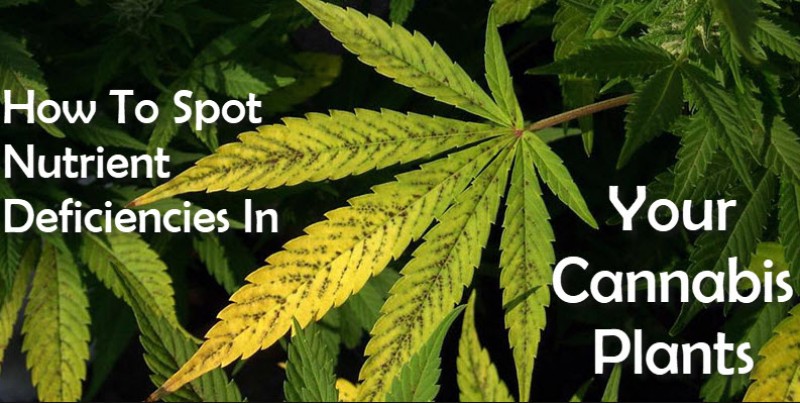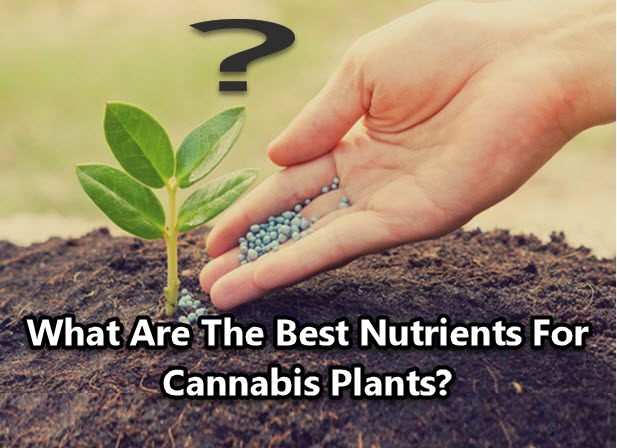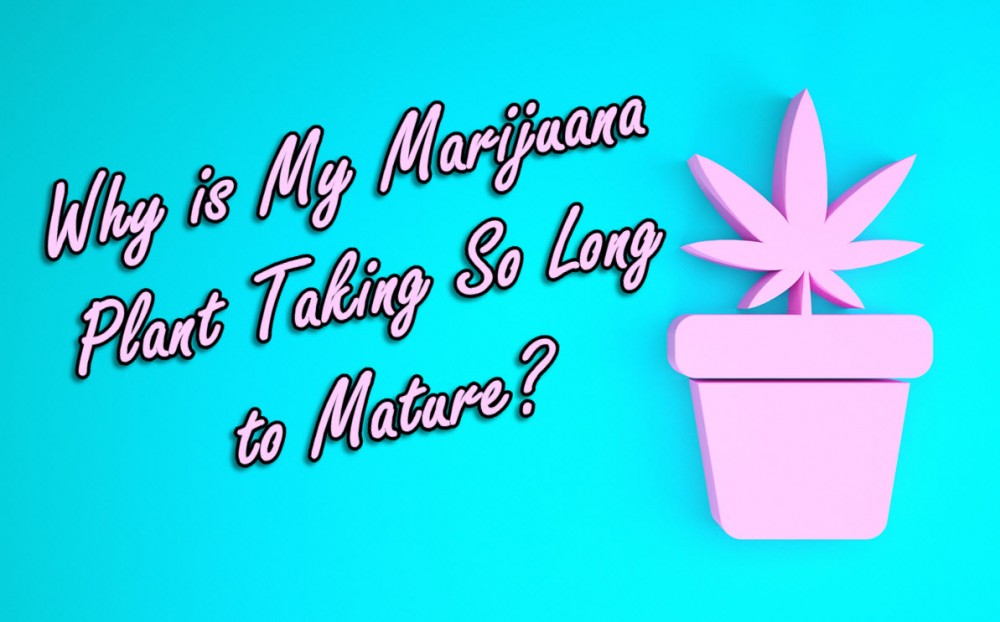How To Spot Nutrient Deficiencies In Your Cannabis Plants
What Nutrient Problems Do Your Pot Plants Have? from CannabisNet on Vimeo.
Just like humans, your cannabis plants need the right nutrients to thrive. There are many different kinds of nutrients that cannabis plants need, and any deficiencies will show up through telltale signs on the plant itself.
The main macronutrients needed for cannabis plant health are nitrogen (N), phosphorus (P), and potassium (K). These elements are represented in numerical form in all plant food labels. Micronutrients are just as important; many of them are already built into potting soils. These micronutrients include calcium (Ca), manganese (Mn), magnesium (Mg), sulfur (S), zinc (Zn), boron (B), Iron (Fe), Chlorine (CL), copper (Cu), and molybdenum (Mo).
The best way to prevent nutrient deficiencies is by paying close attention to the pH levels of the nutrient solution you’re using. Other effective and useful ways to prevent deficiencies are by checking the heat controls and watering plants properly.
However, in the case of nutrient deficiencies, these are the signs that your plant has too much or too little of either a macronutrient or a micronutrient:

Macronutrients:
Nitrogen (N): Older and lower cannabis leaves will turn yellow or brown, wilt, and die off. Nitrogen, like magnesium, travels from one leaf to another; it plays an important role in photosynthesis which gives the plant its green color. New leaves are green since they are loaded with nitrogen but older leaves will become yellow or brown.
In the flowering stage, it’s normal for the cannabis plant to lose some nitrogen since the plant itself becomes deficient when in the process of producing buds. However, as a cultivator it isn’t good to have a nitrogen deficiency during the vegetative stage. Avoid nitrogen deficiencies by ensuring you are feeding your cannabis plants with nutrients that have a high nitrogen content. When the pH levels are too low, the plant will not absorb the nitrogen effectively. This can all be avoided by using a high nitrogen nutrient solution.
Phosphorus (P): Older and lower cannabis leaves will turn dark green or yellow, may start having big blue or brown splotches or spots; they may end up thickening and curling up and the affected leaves will feel stiff. In some cases, the stems of the plant will turn bright purple or red although this isnt’ always the case.
A phosphorus deficiency during the vegetative stage tends to manifest at the bottom of the plant where the oldest leaves are located, and will eventually climb up if the deficiency isn’t treated. Cannabis plants love more phosphorus during the flowering stage, although the cannabis plant uses it in all stages of its growth. The risks for a plant to get too much phosphorus if they are being fed with standard nutrients created specifically for flower plants such as cannabis. Almost all flowering nutrients will be abundant in phosphorus. If you encounter a phosphorus deficiency even if you’re using a standard cannabis nutrient, this may actually be the sign of a root pH problem.
Potassium (K): Potassium deficiencies are more likely to occur in plants that are grown in reverse osmosis or heavily filtered water. Symptoms may show itself in the older leaves or on the top of the plant; these leaves will turn brown, yellow, or seem like they have burnt tips on its edges. Depending on the case, brown burnt edges may show up first, or the leaves will turn yellow first. If both symptoms are present, it’s almost a guarantee that your cannabis plants have a potassium deficiency.
In some potassium deficiencies, the stems may weaken and plants may stretch too. The leaf symptoms of a potassium deficiency may resemble that of an iron deficiency because they can turn a bright yellow but the leaf tips will curl when the edges are brown, and eventually will burn off and die.
Potassium deficiencies can get worse with overwatering; so best to diagnose it first before you hydrate your plants further. If your plants are too close to a light, such as LED’s and HPS grow lights, this can give your cannabis plants a “sunburnt” look even if the temperatures aren’t hot. The sunburn look from the plants being too close to the lights may resemble a potassium deficiency although this is actually a light burn.
Potassium deficiencies can be remedied by adjusting the pH to the correct range; potassium is best absorbed in soil by the roots in a 6.0-7.0 pH range while in hydro or coco coir, the pH levels should be in the 5.5 – 6.5 pH range.

Micronutrients:
Boron: Thick or abnormal growth tips with brown/yellow spotting on new leaves is the first sign of a boron deficiency. Typically, the upper leaves in a cannabis plant will suffer from slowed growth. Boron is most effectively absorbed using low pH ranges because at high pH ranges, the plant is likely not absorbing the right amount. To remedy a boron deficiency, check on the pH levels; hydroponic grows should have a pH range from 5.5-5.8.
Copper: Purple or dark blue undertones on leaves, shiny leaf surfaces, and yellow tips or edges are signs of a copper deficiency. If your cannabis buds don’t ripen or you notice that they are growing extremely slow, this could also be another sign of a copper deficiency. This occurs when the pH levels aren’t adjusted properly; avoid a copper deficiency by regularly testing pH levels and adjust when needed.
Calcium: A calcium deficiency is trickier to diagnose. Crinkling, dead spots, brown spots, distorted or small leaves, stunted growth, dark green around affected areas, and curled tips are the telltale signs of a calcium deficiency. Calcium as well as iron and magnesium deficiencies usually occur together. Remedy a calcium deficiency by flushing your plants using clean pH neutral water followed up by adding a water nutrient solution. Cal-Mag supplements for nutrient-water solutions can further prevent calcium and magnesium deficiencies from reoccurring.
Iron: If you see new leaves that are entirely yellow, this is a sign of an iron deficiency. Although iron and magnesium deficiencies look alike, with an iron deficiency it is clearly the newest leaves that are completely yellow. If the pH levels are too high, such as at a 7, iron isn’t absorbed well by the cannabis plant. Iron deficiencies are rare when using hydroponic grows; but if this happens, the solution would be to flush the system using pH neutral water then adjust the range appropriately.
Magnesium: With a magnesium deficiency, a cannabis plant’s outer edges and veins will be light green to yellow in color. Magnesium, a mobile nutrient, can travel around the plant from old to new leaves. Cannabis plants are more prone to magnesium deficiencies if the pH levels are too low, and it’s more common in hydroponic grows. Magnesium may be present but the roots are unable to absorb it, so even adding magnesium supplements won’t solve the problem. The way to remedy a magnesium deficiency is by increasing pH levels to 6.0 until the symptoms go away, then reduce the pH down to 5.5-5.8.
Nitrogen: Nitrogen deficiencies cause the older, lower cannabis leaves to become yellow or brown, wilt, and die off. Nitrogen is also a mobile nutrient that travels around from one leaf to another. Nitrogen is critical to photosynthesis. In cannabis plants that have a nitrogen deficiency, the new leaves are green since they are packed with nitrogen but the older leaves turn brown or yellow, wrinkle up, and will die. In the flowering stage, nitrogen deficiencies are normal since the cannabis plant will lose nitrogen while producing buds. However, nitrogen deficiencies during the vegetative stage should be avoided. Nitrogen deficiencies can be prevented by ensuring that the plants are being fed with appropriate levels of nitrogen. If the pH levels are too low, the plant won’t be able to absorb the nitrogen. But if you use a high nitrogen solution, this can be avoided.
Zinc: A telltale sign of a zinc deficiency are yellow veins in the plants. The cannabis leaf tips will also show a discoloration and will begin to die. In some cases, a zinc deficiency is caused by stressful conditions such as plant shock or sudden change in environment. However, once the plant has gotten over the stress, they can usually survive to full maturity. Zinc deficiencies tend to occur when the pH levels are not adjusted properly; when the pH levels are too high, zinc cannot be absorbed by the plant.
Nitrogen toxicity: Unlike a nitrogen deficiency, a nitrogen toxicity occurs when the plant takes in too much nitrogen. This leads to symptoms such as slow and stunted growth, weak stems, and dark green leaves. Cannabis leaves suffering from nitrogen toxicity tend to form claw-like leaves which occurs when the leaves curl inwards, resembling a talon which will turn yellow then die. Fluctuations in pH levels, and exposure to heat will cause the claw-like condition to spread throughout the plant. Nitrogen is crucial in the vegetative stage but not so much in the flowering stage. You can more effectively maintain the healthy nitrogen levels by using a high-nitrogen nutrient solution during the vegetative phase, then once the plant reaches the flowering stage, switch to a lower-level nitrogen nutrient solution.
Key Takeaways
To grow healthy cannabis plants that thrive throughout their phases requires paying close attention to the environment and actively monitoring pH levels throughout. Doing so may take time and patience but it will be worth the effort once you see your harvest.
OTHER STORIES YOU MAY ENJOY..
CANNABIS PLANT DEFICIENCIES, READ HOW TO FIX THEM FAST!
OR...
BEST NUTRIENTS FOR CANNABIS PLANTS, CLICK HERE.
OR..
HOW MUCH GRASS CAN YOU GROW AT HOME? CLICK HERE.









